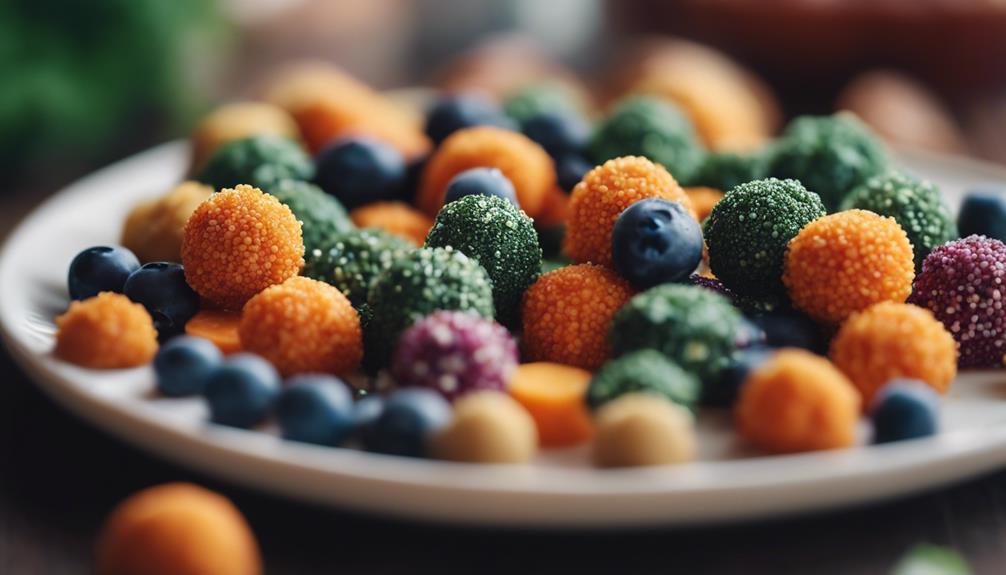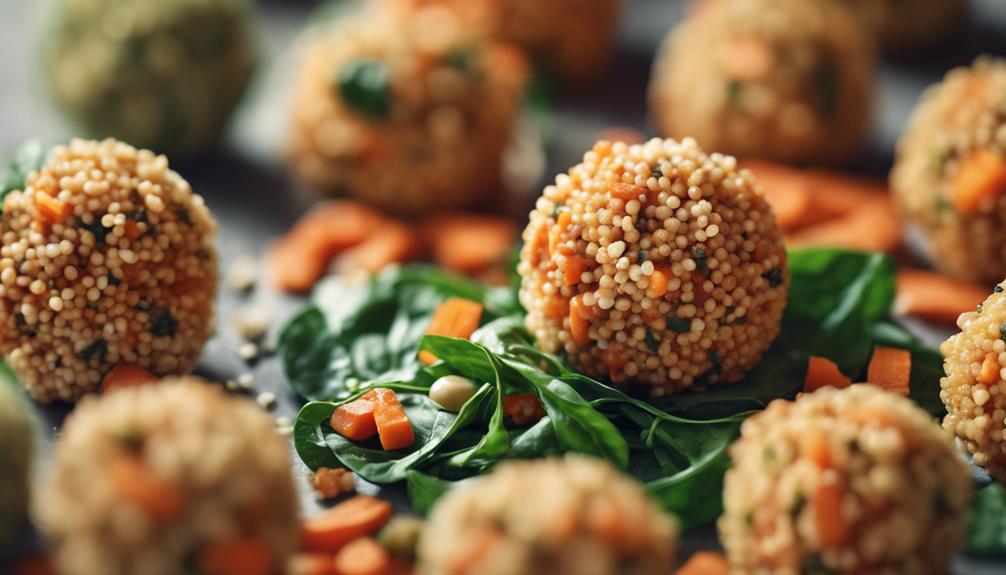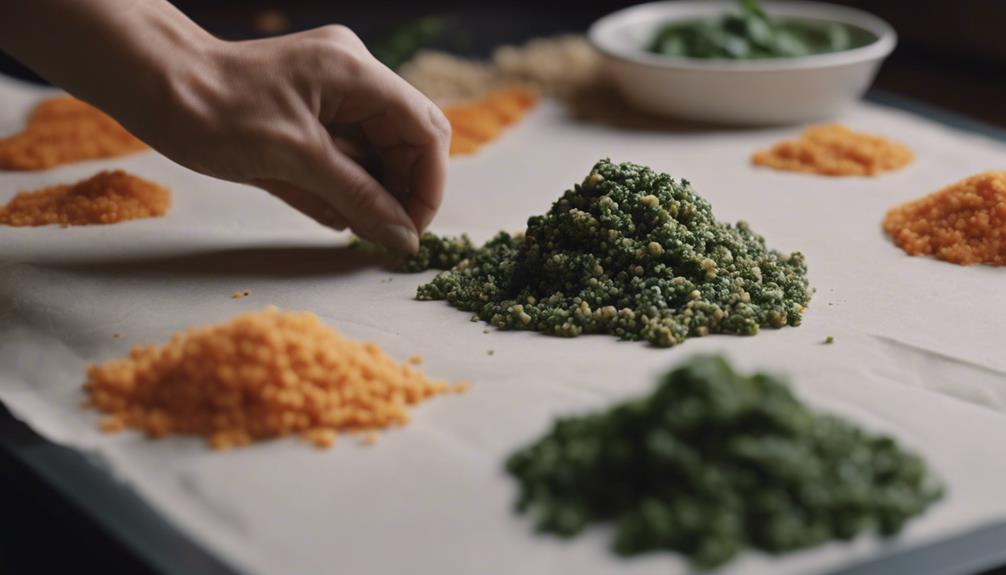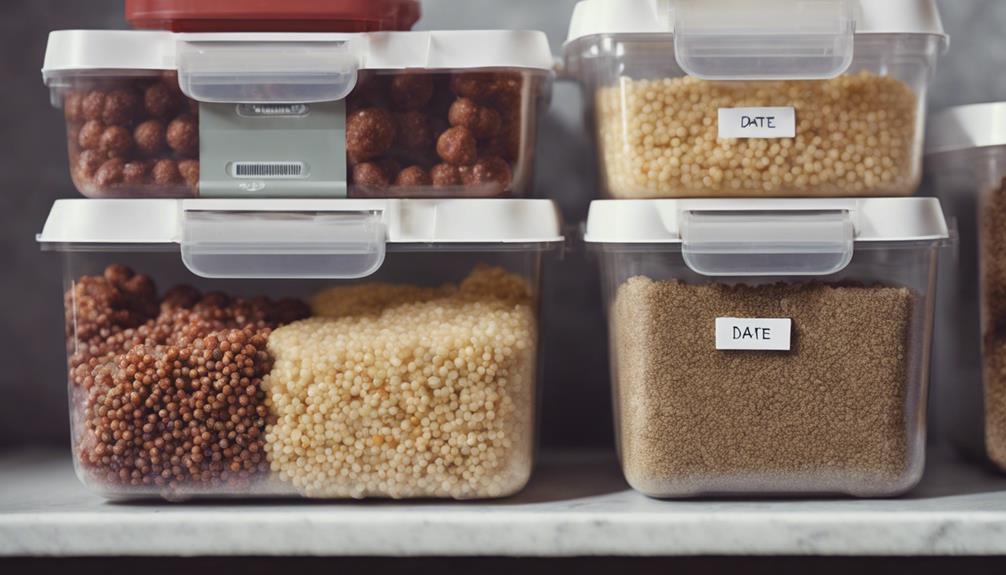Looking to provide your little one with a healthy snack that’s quick and easy to make? Quinoa balls for babies are the perfect solution! Loaded with essential amino acids, vitamins, and minerals, these tasty treats are sure to be a hit. Simply rinse quinoa, mix in spinach, cheese, tomatoes, and breadcrumbs, then shape into balls. Quinoa’s iron content is beneficial for brain development, plus it’s gluten-free and gentle on the stomach. Be sure to double-check labels and consider substitutes for any allergy concerns, and don’t forget you can freeze them for later. Looking for more cooking tips, variations, and storage ideas? Keep exploring the possibilities for enjoyable and nutritious snacking moments with your little one!
Key Takeaways
- Quinoa balls offer essential amino acids and iron for baby's growth and development.
- Freeze quinoa balls for future use in convenient baby meals.
- Experiment with different grains and allergy-friendly options for diverse dietary needs.
- Ensure proper freezing, thawing, and reheating techniques to retain texture and flavor.
- Encourage self-feeding skills by presenting quinoa balls in finger food form for babies.
Key Ingredients
Discover the essential key ingredients for making nutritious quinoa balls for your baby. Quinoa, a powerhouse of nutrients, provides all nine essential amino acids important for your baby's growth and development.
By incorporating spinach into these balls, you're not only adding essential vitamins and minerals like iron, calcium, and vitamin K but also boosting the flavor profile.
The addition of shredded cheese not only enhances the taste but also offers essential calcium and protein necessary for bone development and overall growth.
Tomatoes bring in lycopene, an antioxidant that supports your baby's immune system and overall well-being.
Lastly, breadcrumbs not only add texture but also provide an extra source of fiber, aiding in your baby's digestive health.
With this wholesome combination of quinoa, spinach, cheese, tomatoes, and breadcrumbs, you're ensuring your little one receives a balanced meal packed with essential nutrients, vitamins, minerals, antioxidants, and fiber.
Recipe Preparation

When preparing quinoa balls for your baby, make sure to rinse the quinoa thoroughly to remove any bitterness.
Remember to maintain a 1:2 ratio of quinoa to water for that perfect fluffy texture.
Avoid the temptation to stir the quinoa while it's cooking to prevent a mushy outcome.
Baby-Friendly Quinoa Varieties
Exploring various baby-friendly quinoa varieties opens up a world of nutritious and tasty options for your little one's meals. When it comes to baby-led weaning, incorporating quinoa into recipes like quinoa balls or quinoa bites can provide essential amino acids, iron, protein, and a host of other nutrients vital for your baby's healthy growth. These recipes often feature a mix of quinoa with vegetables, offering a delicious way to introduce different flavors and textures to your baby's palate.
Rinsing quinoa thoroughly before use is key to maintaining a light and fluffy texture, making it easier for your baby to chew and swallow. Additionally, presenting quinoa in finger food form allows your little one to grasp and explore the food independently during mealtime, fostering a sense of curiosity and self-feeding skills.
Don't be afraid to experiment with different grains as substitutes for quinoa to cater to your baby's individual taste preferences and dietary needs. By incorporating these baby-friendly quinoa varieties into your little one's diet, you're not only providing a healthy meal but also setting the stage for a lifetime of nutritious eating habits.
Quinoa Preparation Techniques
To prepare quinoa for your baby's meals, start by thoroughly rinsing it to remove bitterness and starch, guaranteeing a light and fluffy texture ideal for baby-led weaning.
Even if the quinoa is labeled as pre-rinsed, using a large sieve over the sink can effectively get rid of any residual bitterness.
Following the cooking instructions on the packaging is essential to maintain its nutritional value and provide the ideal texture for your little one.
Making quinoa into finger food can help your baby grasp and eat it easily, fostering independent feeding skills.
Quinoa isn't only nutritious but also easily digestible, packed with essential nutrients like protein, iron, and magnesium, making it a fantastic choice for baby-led weaning.
Nutritional Benefits

For ideal nutrition, consider the significant benefits that quinoa offers when introducing it to your baby's diet.
Quinoa is a powerhouse grain, packed with essential nutrients like protein, fiber, vitamins, and minerals, making it an excellent choice for baby-led weaning.
Its complete protein source status, containing all nine essential amino acids important for infant growth, sets it apart.
The iron content in quinoa is important for healthy brain development and immune function as your little one shifts to solid foods.
Furthermore, being gluten-free and easy to digest, quinoa is a versatile ingredient that can be creatively included in various baby-friendly recipes.
By incorporating quinoa into your baby's diet, you can promote satiety, provide sustained energy, and fulfill overall nutritional needs during the weaning process.
Allergy-Friendly Options

When preparing these allergy-friendly quinoa balls, it's crucial to diligently check labels for potential allergens to guarantee a safe eating experience.
For those with egg or dairy allergies, swapping in ingredients like flax eggs and non-dairy cheese can make the quinoa balls suitable for consumption.
Individuals with gluten intolerance can enjoy these tasty treats by using certified gluten-free oats in the recipe.
By being mindful of allergens and making appropriate substitutions, quinoa balls become a versatile and inclusive snack option.
Cooking Tips and Substitutions

Check out these practical cooking tips and easy ingredient substitutions to enhance your quinoa ball-making skills and cater to various dietary needs. When preparing quinoa balls, always remember to rinse the quinoa thoroughly to get rid of any bitterness and excess starch, ensuring a tastier end product. For a vegan-friendly option, swap out traditional eggs with flax eggs in your quinoa ball recipes. Get creative by incorporating different vegetables like sweet potatoes or carrots to boost the nutrition and introduce new flavors to your baby. Don't be afraid to adjust the seasoning and spices to match your little one's taste preferences and make mealtime more exciting. Additionally, try using oat flour instead of rolled oats for a smoother texture in your quinoa balls. These simple cooking tips and substitutions will not only make your quinoa balls more delicious but also allow you to customize them to suit your baby's needs and explore a variety of flavors.
| Tips and Substitutions | Description |
|---|---|
| Rinse Quinoa | Eliminates bitterness and excess starch for better taste and texture. |
| Flax Eggs | Vegan-friendly alternative to traditional eggs in quinoa ball recipes. |
| Different Vegetables | Experiment with veggies like sweet potatoes or carrots for added nutrition and flavor. |
User Engagement and Feedback

Engage with fellow readers by sharing your thoughts, experiences, and creative adaptations of the quinoa balls recipe in the comments section below.
The joy of cooking isn't only in the process but also in the connections we make over shared recipes we love.
Whether you're a seasoned pro at weaning your little one onto solid foods or just looking for a new baking adventure, your feedback is invaluable.
Did you try making the quinoa balls in different shapes or sizes to suit your baby's preference for one-bite snacks?
Maybe you discovered the perfect baking time to achieve that golden brown crust in your oven.
Share your tips and tricks with the community; we're all in this delicious food journey together.
Your feedback helps us improve and innovate, making the quinoa balls recipe a versatile favorite among households.
Freezing and Storage Instructions

Freezing and storing your quinoa balls properly is important to maintain their quality and flavor for future consumption. When preparing your quinoa balls for freezing, make sure they're completely cooled before transferring them to an airtight container. This step is essential to prevent freezer burn and maintain freshness.
For convenient meal prep, you can freeze your quinoa balls for up to three months without compromising their taste.
When you're ready to enjoy your frozen quinoa balls, remember to thaw them in the refrigerator overnight or at room temperature for a few hours. Once thawed, reheat your quinoa balls in the oven for the best results. Make sure they're heated through before serving to retain their delicious texture and flavor.
Properly frozen and stored quinoa balls will preserve their quality, making them a convenient and nutritious option for your baby's meals.
Frequently Asked Questions
Is Quinoa Healthy for Babies?
Quinoa is indeed healthy for babies. It's a nutritious whole grain packed with protein, fiber, and essential nutrients. It's gluten-free, easy to digest, and a great source of iron. Introducing quinoa can diversify your baby's diet for excellent growth and nutrition.
What Is the Healthiest Way to Eat Quinoa?
To eat quinoa healthily, incorporate it into balanced meals. Cooking quinoa in water or broth maintains flavor and texture. Avoid excessive oil, salt, and sugar. Pair it with veggies, lean proteins, and healthy fats for a nutrient-rich meal.
Can I Puree Quinoa for Baby?
You can definitely puree quinoa for your baby! It's a nutritious choice to introduce early. Make sure it's cooked well and blended smoothly with fruits or veggies for a tasty and easily digestible meal that promotes healthy eating habits.
Does Quinoa Help Babies Poop?
Oh, absolutely! Quinoa is a fiber powerhouse that works wonders for your baby's digestive system. It helps regulate bowel movements, prevents constipation, and promotes overall gut health. So, go on and whip up some quinoa balls for that happy tummy!
Conclusion
To sum up, quinoa balls for baby are a nutritious and easy-to-make snack that provides essential nutrients for your little one's growth and development.
Did you know that quinoa is considered a complete protein and contains all nine essential amino acids?
So, not only are these quinoa balls delicious and convenient, but they also pack a powerful nutritional punch for your baby's health.
Give them a try and watch your little one gobble them up with delight!










